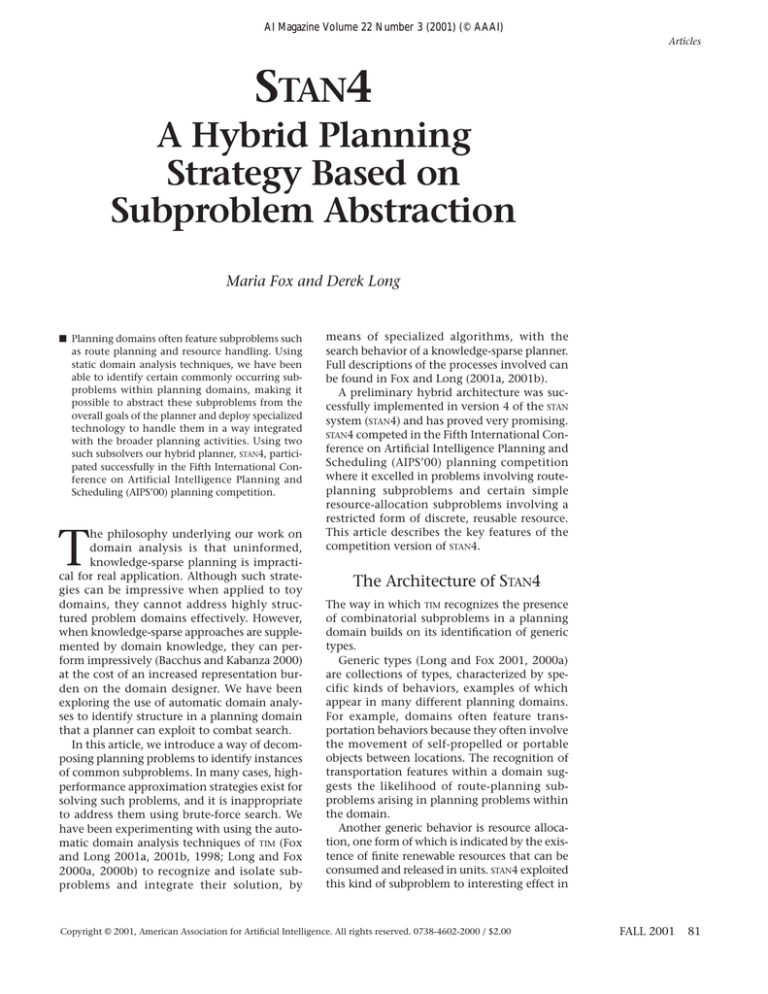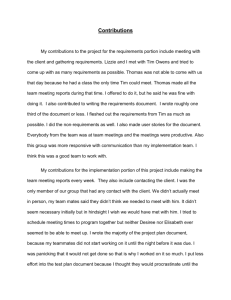
AI Magazine Volume 22 Number 3 (2001) (© AAAI)
Articles
STAN4
A Hybrid Planning
Strategy Based on
Subproblem Abstraction
Maria Fox and Derek Long
■ Planning domains often feature subproblems such
as route planning and resource handling. Using
static domain analysis techniques, we have been
able to identify certain commonly occurring subproblems within planning domains, making it
possible to abstract these subproblems from the
overall goals of the planner and deploy specialized
technology to handle them in a way integrated
with the broader planning activities. Using two
such subsolvers our hybrid planner, STAN4, participated successfully in the Fifth International Conference on Artificial Intelligence Planning and
Scheduling (AIPS’00) planning competition.
T
he philosophy underlying our work on
domain analysis is that uninformed,
knowledge-sparse planning is impractical for real application. Although such strategies can be impressive when applied to toy
domains, they cannot address highly structured problem domains effectively. However,
when knowledge-sparse approaches are supplemented by domain knowledge, they can perform impressively (Bacchus and Kabanza 2000)
at the cost of an increased representation burden on the domain designer. We have been
exploring the use of automatic domain analyses to identify structure in a planning domain
that a planner can exploit to combat search.
In this article, we introduce a way of decomposing planning problems to identify instances
of common subproblems. In many cases, highperformance approximation strategies exist for
solving such problems, and it is inappropriate
to address them using brute-force search. We
have been experimenting with using the automatic domain analysis techniques of TIM (Fox
and Long 2001a, 2001b, 1998; Long and Fox
2000a, 2000b) to recognize and isolate subproblems and integrate their solution, by
means of specialized algorithms, with the
search behavior of a knowledge-sparse planner.
Full descriptions of the processes involved can
be found in Fox and Long (2001a, 2001b).
A preliminary hybrid architecture was successfully implemented in version 4 of the STAN
system (STAN4) and has proved very promising.
STAN4 competed in the Fifth International Conference on Artificial Intelligence Planning and
Scheduling (AIPS’00) planning competition
where it excelled in problems involving routeplanning subproblems and certain simple
resource-allocation subproblems involving a
restricted form of discrete, reusable resource.
This article describes the key features of the
competition version of STAN4.
The Architecture of STAN4
The way in which TIM recognizes the presence
of combinatorial subproblems in a planning
domain builds on its identification of generic
types.
Generic types (Long and Fox 2001, 2000a)
are collections of types, characterized by specific kinds of behaviors, examples of which
appear in many different planning domains.
For example, domains often feature transportation behaviors because they often involve
the movement of self-propelled or portable
objects between locations. The recognition of
transportation features within a domain suggests the likelihood of route-planning subproblems arising in planning problems within
the domain.
Another generic behavior is resource allocation, one form of which is indicated by the existence of finite renewable resources that can be
consumed and released in units. STAN4 exploited
this kind of subproblem to interesting effect in
Copyright © 2001, American Association for Artificial Intelligence. All rights reserved. 0738-4602-2000 / $2.00
FALL 2001
81
Articles
STAN4
TIM
Other Domain
Characteristics
Path-planning or
Resource Management
FORPLAN
STAN3
Path-planner
Resource Manager
Figure 1. The Architecture of the Hybrid System Showing How TIM Selects between FORPLAN
and STAN3 Depending on the Outcome of Domain Analysis.
the FreeCell domain in the competition.
The competition version of STAN4 consists of
the integrated combination of TIM, two distinct
planning strategies, and two specialized subsolvers. Given a problem, TIM is responsible for
invoking an appropriate planner and a specialized strategy. Integration of the specialized
technology with a planner is easiest to achieve
in a heuristic forward-search–based planner
because the states of all variables can be known
at any point during the forward-search process.
We therefore implemented a forward planner,
FORPLAN, using a simple best-first search strategy. FORPLAN is only ever invoked when TIM recognizes that a planning domain contains a
route-planning or resource-allocation subproblem. Before invoking FORPLAN, TIM modifies the
domain description to abstract out the recognized subproblem. FORPLAN is then invoked on
the simplified domain description.
FORPLAN uses a heuristic evaluation function,
based on solving the relaxed planning problem, similar to the approach taken by HSP
(Bonet, Loerincs, and Geffner 1997) and FF
(Hoffmann 2000). Like FF, FORPLAN uses a
82
AI MAGAZINE
relaxed version of GRAPHPLAN (Blum and Furst
1995) to compute the relaxed plan estimate.
However, unlike FF, FORPLAN uses a two-part
process to compute this estimate. In FORPLAN,
the relaxed plan is constructed for the abstracted planning problem, giving only part of the
heuristic estimate. The heuristic estimate is
then improved using the calculations, performed by the appropriate specialized solver, to
estimate the cost of solving the removed subproblem. For example, in the case of routeplanning abstraction, these calculations estimate the cost of traversing the routes between
the locations that must be visited by any
mobile objects used in the plan.
To calculate a shortest path that visits all
these locations and respects any additional
orderings imposed by the plan is a variation on
a traveling salesman problem. We produce an
estimate of the cost using a simple nearestneighbor heuristic, which is an unsophisticated first attempt at integrating a solver for a
traveling salesman problem and does not
always perform well. For example, in the STRIPS
elevator domain, abstract plans require the ele-
Articles
vator to visit a number of pick-up locations
before their corresponding drop-off locations.
The simplest solution for the nearest-neighbor
heuristic is to visit all the pick-up locations
before any of the drop-off locations, resulting
in poor estimates. Better estimates could be
obtained by interleaving the visits, but the
nearest-neighbor heuristic cannot exploit this
possibility. When such interleaving is not
needed (as in logistics), this heuristic gives a
better estimate of the cost than a pure relaxedplan estimate can give. It can be observed,
from the competition data, that STAN4 produced the best-quality plans in all the logistics
problems it could solve, whereas its performance in the elevator domain was variable.
Once an action is selected, it is checked to
determine whether it entails obligations that
must be satisfied by the plan (for example, in
route abstraction, actions in the abstracted
plan entail commitments on mobile objects to
reach key locations). If so, a way of meeting
these obligations is proposed by the specialized
algorithm. In the case of route abstraction, the
subsolver proposes the shortest path between
the current location of the mobile (which is
always known in a forward search) and the
required location, which is recorded in the
action as part of the abstraction process. STAN4
uses Floyd’s (1962) algorithm to compute this
path in static maps.
To be able to compete realistically in the
competition, we needed to be able to report
results for problems that did not have either of
the two generic features that TIM could recognize at this stage in its development. We therefore supplemented FORPLAN with STAN3 (Long
and Fox 1999), a GRAPHPLAN-based planner
exploiting various preprocessing techniques.
We then integrated our route-planning subsolver, and a resource-allocation subsolver,
with the FORPLAN strategy.
An important feature of STAN4 is that TIM fails
safe when it is unable to detect an appropriate
generic structure in a domain. If a domain features a more complex form of mobile than TIM
can recognize, then STAN4 is unable to exploit
the presence of this mobile, but it can still solve
the problem using the uninformed planning
techniques of STAN3. Thus, despite its specialized handling of domains when appropriate,
STAN4 is a domain-independent system.
TIM selects between the two planning strategies according to the structure of the domain.
If the domain contains a recognized subproblem, FORPLAN is invoked. STAN3 is invoked in all
other cases. If FORPLAN is invoked, the domain is
automatically modified to abstract out the subproblem before planning begins. This process
is described in Fox and Long (2001a, 2001b). A
high-level view of the architecture of STAN4 is
presented in figure 1.
Further Work
Although the competition version of STAN4 produced some promising results, the framework
we used to achieve integration was unsophisticated and inflexible. Our subsequent work has
addressed the following points:
First, in the competition version of STAN4, TIM
could only recognize simple mobile types. TIM
is now able to recognize a more diverse range of
mobile types and perform appropriate modifications to enable the route-planning subproblems to be abstracted and handled correctly.
TIM can now identify mobiles that need drivers
to provide their mobility and can solve the driver-allocation subproblem as part of route
planning for these mobiles.
Second, the competition version of STAN4
featured a simplistic integration mechanism,
which was based on attaching subproblem-specific information to domain constructs during
the abstraction process, allowing FORPLAN to
pass specific forms of information to the two
subsolvers. Subsolvers could only pass back
heuristic distance estimates. The support for
two-way communication has now been
improved and generalized into a proper interface between the planning and subsolving levels (Fox and Long 2001a).
Third, in the competition version, STAN4
only supported integration with one specialized subsolver at a time, even when a domain
featured multiple subproblems. The uniform
interface mentioned earlier supports a more
powerful form of integration, allowing multiple subsolvers to communicate with the planner. This area is a focus of ongoing research.
Fourth, the subsolvers integrated with the
competition version are simplistic and produce
poor performance in some domains. The competition version of STAN4 was designed as a
proof of concept, demonstrating that domain
analysis could be used to select intelligently
between alternative problem-solving strategies.
The use of more powerful specialized techniques is now being considered.
The key idea
underlying
our hybrid
approach is
that
uninformed
search is not
appropriate
technology
for solving
all planning
problems.
Conclusions
We have experimented with the design of a
hybrid planning system in which the choice of
problem-solving strategy is made automatically
following static analysis of the domain. Our
preliminary hybrid system, STAN4, gave a
promising performance in the AIPS’00 compe-
FALL 2001 83
Articles
tition but was restricted in terms of the power
of integration that could be supported.
The competition data show that in domains
in which TIM was able to identify exploitable
subproblems, STAN4 gave a good performance,
particularly in terms of plan quality. Its logistics plans were better even than those of
TALPLANNER, which was using hand-coded control knowledge. In the FreeCell and elevator
domains, STAN4 gave a varied performance,
demonstrating that the identification of an
exploitable subproblem, and integration of
appropriate subsolvers, was still at a raw stage
at the time of the competition.
Our primary goal since the competition has
been to improve integration with specialized
solvers, allowing a more sophisticated profile
of subproblems to be managed. The key idea
underlying our hybrid approach is that uninformed search is not appropriate technology
for solving all planning problems. Instead, we
are interested in building up a collection of
purpose-built strategies for combatting some of
the most commonly occurring subproblems
and making these available to a planner,
together with techniques for recognizing
where these problems arise in planning
domains. The decision about how to approach
a given planning problem can then be made
automatically, in a principled way, by deciding
how to view the problem and deploying the
most effective technology to solve it.
References
Bacchus, F., and Kabanza, K. 2000. Using Temporal
Logic to Express Search Control Knowledge for Planning. In Artificial Intelligence, Volume 16, 123–191.
New York: Elsevier Science.
Blum, A., and Furst, M. 1995. Fast Planning through
Planning Graph Analysis. In Proceedings of the Fourteenth International Joint Conference on Artificial
Intelligence, 1636–1642. Menlo Park, Calif.: International Joint Conferences on Artificial Intelligence.
Bonet, B.; Loerincs, G.; and Geffner, H. 1997. A
Robust and Fast Action Selection Mechanism for
Planning. In Proceedings of the Fourteenth National
Conference on Artificial Intelligence, 714–719. Menlo Park, Calif.: American Association for Artificial
Intelligence.
Floyd, R. W. 1962. Algorithm 97: Shortest Path. Communications of the ACM 5(6):345.
Fox, M., and Long, D. 2001a. Extending the Recognition and Use of Mobility in Planning Domains. Technical report, Department of Computer Science, University of Durham.
Fox, M., and Long, D. 2001b. Hybrid STAN: Identifying and Managing Combinatorial Optimization Subproblems in Planning. Paper presented at the Seventeenth International Joint Conference on Artificial
Intelligence, 4–11 August, Seattle, Washington.
Fox, M., and Long, D. 1998. The Automatic Inference
84
AI MAGAZINE
of State Invariants in TIM. Journal of AI Research
9:367–421.
Hoffmann, J. 2000. A Heuristic for Domain-Independent Planning and Its Use in an Enforced Hill-Climbing Algorithm, Technical report, Institute for Computer Science, Albert-Ludwigs University.
Long, D., and Fox, M. 2001. Planning with Generic
Types. Technical report, Department of Computer
Science, University of Durham.
Long, D., and Fox, M. 2000a. Automatic Synthesis
and Use of Generic Types in Planning. In Proceedings
of the Fifth International Conference on AI Planning and
Scheduling, 196–205. Menlo Park, Calif.: AAAI Press.
Long, D., and Fox, M. 2000b. Extracting Route Planning: First Steps in Automatic Problem Decomposition Workshop on Analyzing and Exploiting Domain
Knowledge for Efficient Planning. Presented at the
Fifth International Conference on Artificial Intelligence Planning and Scheduling, 14–17 April, Breckenridge, Colorado.
Long, D., and Fox, M. 1999. The Efficient Implementation of the Plan-Graph in STAN. Journal of AI
Research 10:87–115.
Maria Fox is reader in computer
science at the University of
Durham, United Kingdom, where
she has worked since 1995. She
previously held a lectureship at
University College London. Fox
has been working in AI planning
since obtaining her Ph.D. in 1989.
In collaboration with Derek Long,
she developed the STAN and TIM systems. Her main
interests are in domain-independent planning and
preplanning domain analysis techniques. Her e-mail
address is maria.fox@durham.ac.uk.
Derek Long is a lecturer in computer science at Durham University, United Kingdom. He joined the
department in 1995 after lecturing
at University College London for
six years. He obtained his doctorate at the Programming Research
Group, Oxford University, in
1989. Since then, he has pursued
interests in reasoning techniques in general and in
planning in particular. He has worked in close collaboration with Maria Fox for the last 10 years. His email address is d.p.long@durham.ac.uk.




